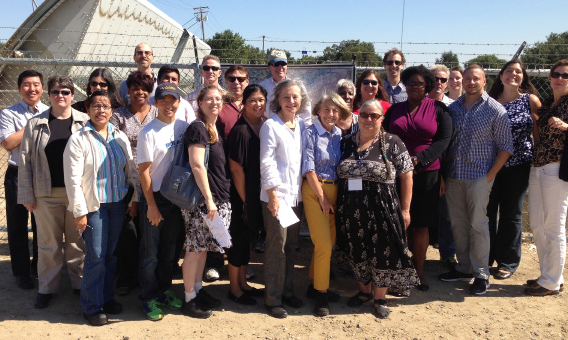The triple threats of sea-level rise, seismic risk and subsidence, as they affect water supply reliability and ecosystem restoration, were vividly conveyed to a group of California Public Utilities Commission (CPUC) advisors and staff during a tour of the Sacramento-San Joaquin River Delta (Delta) on August 22, 2013. The Delta, formed by the confluence of the Sacramento and San Joaquin Rivers, consists of 57 reclaimed islands and tracts and approximately 1,100 miles of protective levees. Approximately 28 million acre-feet of water flows through the Delta annually forming the hub of California’s water supply system.
The California Water Association (CWA) and the Metropolitan Water District of Southern California (Metropolitan) joined together to host the tour for the CPUC’s Low Income Oversight Board (LIOB) and CPUC staff, including Commissioners Carla Peterman and Catherine Sandoval. The LIOB, chaired by Jose Hernandez of IDEATE California in Burbank and co-chaired by Jason Wimbley of the California Department of Community Services and Development, advises the CPUC on low-income electric, gas and water corporation customer issues.
Curt Schmutte, a water resources and environmental planning consultant for Metropolitan, conducted the Delta tour, which originated in Sacramento with a video presentation. The tour included stops along Highway 160 at the Delta Cross Channel; two Delta islands – Twitchell and Sherman – where the subsidence is most pronounced; the Clifton Court Forebay; the Skinner Delta Fish Protective Facility; and the Harvey O. Banks Pumping Plant, where 11 pumps lift the water 244 feet up into the California Aqueduct.
The tour participants learned that all aspects of the Delta are deteriorating, including supply reliability, ecosystem viability, loss of native fish due to invasive species, recreational opportunities and agricultural/economic prosperity. In short, the Delta’s status quo is unsustainable without significant investments to slow the effects of subsidence, saltwater intrusion, loss of wetlands, levee failures and sea-level rise resulting from climate change impacts. Schmutte explained that seismic vulnerability underpins all these problems, with a 62 percent probability of a magnitude 6.7 or greater earthquake on one of the 11 Bay Area earthquake faults.
Schmutte’s work with Metropolitan has encompassed analyzing and implementing seismic flood risk mitigation strategies, planning emergency actions to protect Delta smelt and advancing new conceptual water conveyance alternatives to achieve a sustainable Delta for both water supplies and the ecosystem. He also has worked for the California Department of Water Resources for 21 years where he managed the California Department of Water Resources’ (CDWR) levee improvement program.
CDWR operates the State Water Project, which is the largest state-built water and power project in the United States. Beginning at Lake Davis in Northern California and spanning 600 miles south to Southern California, the State Water Project includes 34 storage facilities, 20 pumping plants, four pumping-generating plants, 5 hydroelectric power plants and about 700 miles of canals, tunnels and pipelines. The State Water Project provides drinking water for 23 million people and irrigation water for 750,000 acres of farmland.
Since the mid-19th century, the levee system has caused nearly 500,000 acres of Delta land to be drained and reclaimed. During that time, the oxygen-rich soils used for farming were exposed to oxygen, causing microbial decomposition of the soils, which has released enormous amounts of carbon dioxide and has resulted in profound land subsidence. Currently, most of the Delta is below sea level, with much of the western and central Delta 20 to 30 feet below sea level. This land subsidence, which is occurring at a rate of 1.5 feet per decade, has weakened the protective levees and increased the threat of floods and loss of freshwater supplies from saltwater intrusion.
Given that 30-35 percent of the water for the Bay Area and Southern California comes from the Delta, and with the Central Valley also heavily dependent on that water, these interrelated problems and solutions must be a top priority for all Californians. The tour participants gained a first-hand understanding of the decisions the state must make in the near future to sustain the water supply, local environment and the state’s economy, all of which depend on a healthy Delta ecosystem.
For more details, visit http://www.water.ca.gov/state_water_project_home.cfm, http://baydeltaconservationplan.com/or http://deltacouncil.ca.gov/.





